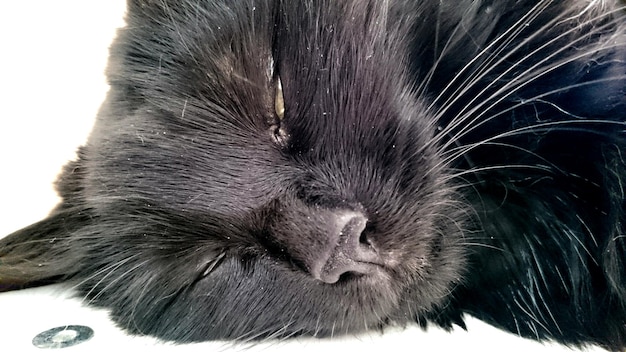Respiratory Infections: Symptoms & Care for Your Pet’s Health

Respiratory infections in pets can range from mild colds to severe pneumonia; recognizing symptoms early and providing appropriate supportive care are vital for your pet’s recovery and long-term health.
Is your furry friend coughing or sneezing more than usual? Respiratory infections: Recognizing the Symptoms and Providing Supportive Care for Your Pet is crucial for their well-being. Let’s explore how to help your pet breathe easier!
Understanding Respiratory Infections in Pets
Respiratory infections can affect pets of all ages and breeds, impacting their ability to breathe comfortably and maintain overall health. These infections can range from mild upper respiratory issues to more severe lower respiratory diseases.
Recognizing the signs and understanding the underlying causes are essential steps in providing timely and effective care for your beloved companions.
Common Causes of Respiratory Infections
Several factors can lead to respiratory infections in pets. Viruses and bacteria are among the primary culprits, often spreading through close contact with other animals. Understanding these causes can aid in prevention.
- Viral Infections: Viruses like canine influenza virus (CIV) and feline herpesvirus (FHV-1) are common causes of upper respiratory infections.
- Bacterial Infections: Bacteria such as Bordetella bronchiseptica (responsible for kennel cough in dogs) can also lead to respiratory issues.
- Fungal Infections: In some regions, fungal spores inhaled from the environment can cause respiratory infections, particularly in pets with weakened immune systems.
- Parasitic Infections: Lungworms and other parasites can infest the respiratory tract, causing inflammation and breathing difficulties.
Knowing the common causes enables pet owners to take preventive measures such as vaccination and avoiding exposure to infected animals.

Recognizing Early Symptoms
Early detection of respiratory infections can greatly improve the prognosis for your pet. Recognizing the initial signs is crucial for seeking prompt veterinary care.
Be vigilant for any changes in your pet’s breathing patterns, behavior, or overall health. Early intervention can prevent the condition from worsening.
Recognizing the Symptoms: What to Look For
Identifying the symptoms of respiratory infections early can make a significant difference in the outcome. Keep a close watch on your pet’s behavior and physical condition.
Symptoms can vary depending on the type and severity of the infection, but there are some common signs that every pet owner should be aware of.
- Coughing: A persistent cough, whether dry or productive, is a common symptom.
- Sneezing: Frequent sneezing can indicate an upper respiratory infection.
- Nasal Discharge: Runny nose with clear, yellow, or green discharge is a key sign.
- Eye Discharge: Watery or pus-like discharge from the eyes is often present.
Prompt recognition of these symptoms can lead to earlier diagnosis and treatment, improving your pet’s chances of a speedy recovery.
It’s important to note that symptoms can sometimes be subtle. For example, a cat might simply become less playful or a dog might seem more tired than usual. Any deviation from normal behavior warrants attention and possibly a visit to the veterinarian.
Diagnostic Tests: Confirming the Infection
When your pet exhibits symptoms of a respiratory infection, your veterinarian will likely perform several diagnostic tests to confirm the diagnosis and identify the specific cause. Accurate diagnosis is essential for effective treatment.
These tests help in distinguishing between different types of infections and ruling out other potential health issues.
Types of Diagnostic Tests
A variety of tests are available to help diagnose respiratory infections in pets, each providing valuable information about the nature and extent of the infection.
These tests may include physical examinations, laboratory tests, and imaging techniques.
- Physical Examination: Listening to the lungs with a stethoscope can reveal abnormal sounds like wheezing or crackling.
- Blood Tests: Complete blood counts (CBC) can indicate the presence of infection and its severity.
- Nasal or Throat Swabs: These swabs can be tested for viruses and bacteria using PCR (polymerase chain reaction) or culture methods.
The veterinarian will choose the most appropriate tests based on the pet’s symptoms and medical history. These tests provide crucial information for developing a targeted treatment plan.
Providing Supportive Care at Home
Supportive care at home is crucial in helping your pet recover from a respiratory infection. These measures aim to alleviate symptoms and promote healing.
Creating a comfortable and stress-free environment can significantly aid in your pet’s recovery process.
Creating a Comfortable Environment
A comfortable and clean environment is essential for pets recovering from respiratory infections. This includes ensuring their space is free from irritants and allergens.
Providing a quiet, warm place where your pet can rest undisturbed is key to their well-being during recovery.
Furthermore, ensuring good ventilation and avoiding exposure to smoke or strong odors can reduce irritation to the respiratory system.
Hydration and Nutrition
Maintaining proper hydration and nutrition is vital for pets battling respiratory infections. These infections can sometimes lead to decreased appetite and dehydration.
Encouraging your pet to drink plenty of water and eat nutritious food can help boost their immune system and speed up recovery.
- Encourage Water Intake: Ensure fresh water is always available. If your pet is reluctant to drink, try offering flavored water or broth.
- Nutritious Diet: Provide a balanced diet that supports immune function. Consult your veterinarian for specific recommendations.
- Soft Food Options: If your pet has a sore throat, soft, easily digestible food can be more appealing and easier to swallow.

Proper hydration and nutrition are foundational aspects of supportive care. They help maintain overall health and support the body’s ability to fight infection.
When to Seek Veterinary Intervention
While providing supportive care at home is important, there are instances when veterinary intervention is necessary. Knowing when to seek professional help can be life-saving for your pet.
If your pet’s condition worsens despite your best efforts, or if certain critical symptoms appear, immediate veterinary care is essential.
Signs That Require Immediate Veterinary Care
Certain symptoms indicate that a respiratory infection requires urgent veterinary attention. These signs suggest a more serious underlying issue.
Prompt diagnosis and treatment can prevent complications and improve the chances of a full recovery.
- Difficulty Breathing: Labored breathing, rapid breathing, or gasping for air are all signs of severe respiratory distress.
- Blue Gums: Bluish discoloration of the gums indicates a lack of oxygen and requires immediate intervention.
- Lethargy: Extreme weakness or unresponsiveness is a sign of severe illness.
- Loss of Appetite: Refusal to eat for more than 24 hours can lead to dehydration and further weaken the immune system.
Delaying veterinary care can lead to complications such as pneumonia or even respiratory failure. If you observe any of these signs, contact your veterinarian immediately.
Prevention: Minimizing the Risk of Infection
Preventing respiratory infections is always preferable to treating them. Taking proactive measures can significantly reduce the risk of your pet contracting these illnesses.
Vaccination, good hygiene practices, and a healthy lifestyle are key components of preventive care.
Vaccination Strategies
Vaccination is one of the most effective ways to protect your pet from common respiratory infections. Regular vaccinations can significantly reduce the risk of contracting these illnesses.
Consult your veterinarian to determine the appropriate vaccination schedule for your pet, based on their age, breed, and lifestyle.
These vaccines can protect against common viruses and bacteria, such as canine influenza, feline herpesvirus, and Bordetella bronchiseptica.
Maintaining Good Hygiene
Good hygiene practices can also help prevent the spread of respiratory infections. Regular cleaning of your pet’s living environment and grooming can reduce their exposure to pathogens.
Washing your hands after interacting with other animals, avoiding crowded environments, and keeping your pet’s belongings clean can all help minimize the risk of infection.
| Key Point | Brief Description |
|---|---|
| 🤧 Symptoms | Recognize coughing, sneezing, nasal discharge, and eye discharge. |
| 🩺 Diagnosis | Veterinarians use exams, blood tests, and swabs for accurate diagnosis. |
| 💧 Supportive Care | Provide a comfortable environment, hydration, and nutritious food. |
| 🛡️ Prevention | Vaccinate your pet and maintain good hygiene practices. |
Frequently Asked Questions
▼
Common respiratory infections include kennel cough in dogs, caused by Bordetella bronchiseptica, and upper respiratory infections in cats, often caused by feline herpesvirus or calicivirus.
▼
Pets typically contract respiratory infections through close contact with infected animals, inhalation of airborne droplets, or exposure to contaminated surfaces such as shared food bowls.
▼
Mild cases may benefit from supportive care, but veterinary intervention is crucial for severe symptoms. At-home care includes rest, hydration, and a comfortable environment.
▼
Most respiratory infections in pets are not contagious to humans. However, some, like Bordetella, can rarely be transmitted to people with weakened immune systems.
▼
Prevention includes vaccinations, maintaining good hygiene, avoiding contact with sick animals, and providing a healthy diet and lifestyle to boost your pet’s immune system.
Conclusion
Understanding the symptoms, causes, and prevention strategies for respiratory infections can significantly improve your pet’s quality of life. Early detection and appropriate care, whether at home or with veterinary intervention, are essential.





